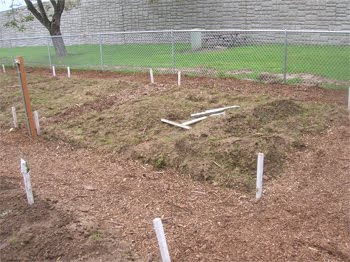Community gardens are top of mind these days for me. I was just notified that I am now the proud (and slightly overwhelmed) renter of a 12-ft. by 12-ft. community garden plot. Pesticides, tires and plastics and paper mulches are not allowed and produce and flowers have to be for home use. But those appear to be the only restrictions.
I’m in the planning stages. A few plants and seeds have been purchased, as have large bags of planting compost. But first I have to figure out before planting how to eliminate the grass starts that are emerging because the grass in the park was just rototilled to create the garden.
I’m relatively new to food gardening so this is going to be a great learning experience for me. So if you have tips, PLEASE share them! Here’s the “before” photo. “After” photos will come as the planting and season progresses.

I know I’m planting more than I’ll be able to eat or share with friends, but I’m doing it so I’ll have produce to share with “Plant a Row for the Hungry” (PAR) and the Oregon Food Bank. PAR was started by the Garden Writers Association to help feed the nation’s hungry by encouraging home gardeners to deliver excess produce to local garden centers on specified days, which then deliver the product to local food banks.
In the Portland area, Farmington Gardens has embraced the program and last year collected more than 6,000 pounds of produce! Farmington Gardens weighs and records your donations so that it can be itemized as a charitable donation at tax time (though I doubt this is why most people donate food). Drop off your produce on Sundays and Wednesday, from 10:30am to noon beginning June 13 and it will find its way to Sunshine Pantry and Tualatin Valley Gleaners. Other area garden centers may offer a similar service; call ahead and ask.
You can stop in at the information desk at either Portland Nursery location (50th and SE Stark St or 90th and SE Division) and look at the Oregon Food Bank notebook, where you can see neighborhood maps and find the closest food pantry, get a handout that gives the list of desired vegetables and other information. And as a thank you from them, you’ll take home a free packet of seeds.
If neither of these nurseries is convenient, getting your extra produce to where it can be used is easy: visit the Oregon Food Bank Web site to see the list of the produce that works best for food boxes and maps where you can locate the food pantry closest to your home. Or, if you want to set up a project to donate fresh produce, contact Eric Sopkin at the Oregon Food Bank (esopkin@oregonfoodbank.org).
